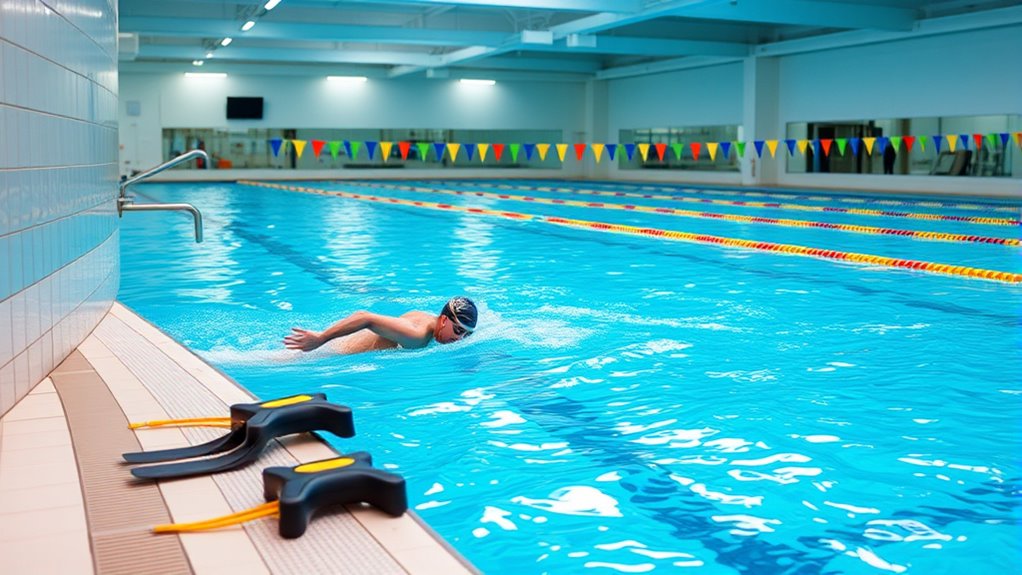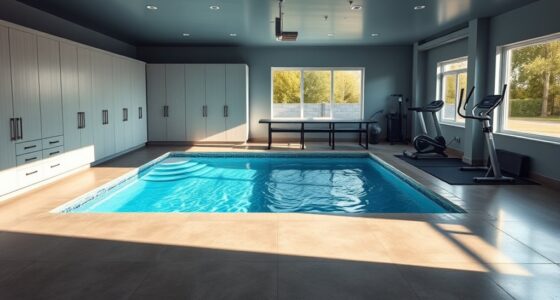To swim faster in your Endless Pool, focus on mastering 12 core technique drills that improve your body position, stroke efficiency, kick strength, breathing rhythm, and turn transitions. Practice streamline drills, catch-up, fingertip drag, kickboard kicks, and breathing exercises regularly. These movements help reduce drag, increase propulsion, and build muscle memory for better form. Keep at it, and you’ll open up faster, smoother swimming—if you continue exploring these drills, you’ll discover even more ways to enhance your speed.
Key Takeaways
- Focus on body position, alignment, and head placement to reduce drag and improve efficiency.
- Incorporate arm and stroke drills like catch-up and fingertip drag to maximize propulsion.
- Use kicking drills with kickboards and varied techniques to build leg strength and power.
- Practice breathing and rhythm exercises, such as the 3-2-1 drill, to enhance stamina and consistency.
- Master flip turns and transitions to maintain momentum and swim faster with better technique.
Streamline Body Position Drills

Have you ever wondered how swimmers glide effortlessly through the water? The secret lies in achieving a perfect streamline body position. To practice this, start by floating on your stomach with your arms extended overhead, palms together, and your body straight. Engage your core muscles to keep your hips high and your body aligned. Focus on keeping your head in a neutral position, looking straight down. Push your fingertips forward, reaching as far as possible without losing alignment. Hold this position for several seconds, feeling the water support you. Repeating these drills helps you develop muscle memory, so maintaining a streamlined body becomes second nature. Mastering this position reduces drag and allows you to move more efficiently through the water. Incorporating water park themed drills can make practicing more engaging and fun.
Catch-Up Drill for Stroke Efficiency
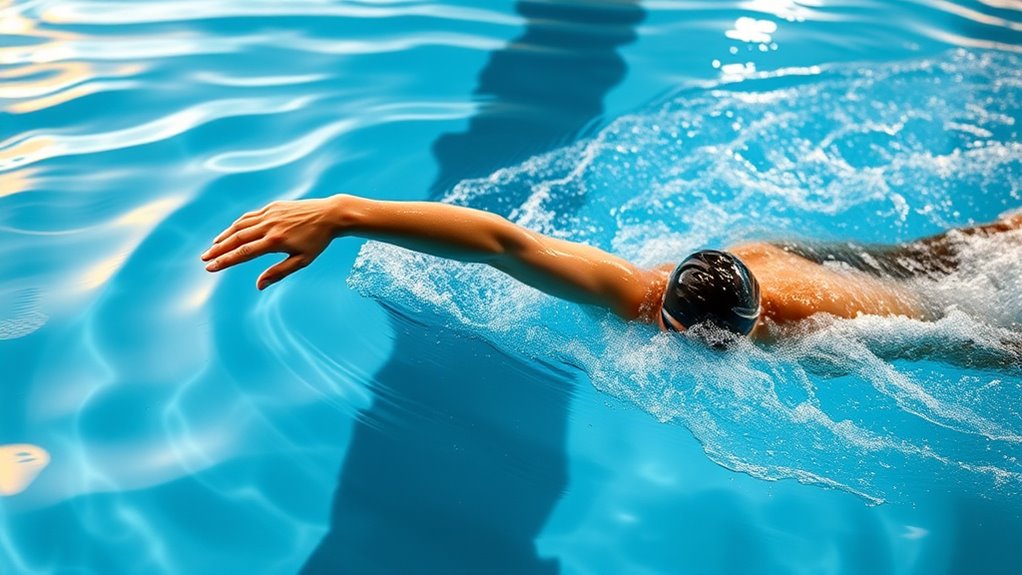
Ever wonder how to improve your stroke timing and efficiency? The Catch-Up Drill helps you synchronize your arm movements smoothly. To do it, start by swimming freestyle, but focus on one arm at a time. Keep one hand extended forward while the other completes a full stroke. When your active hand catches up with the extended one, you pause briefly before starting the next stroke. This pause forces you to focus on maintaining a streamlined body position and proper arm recovery. This drill emphasizes precise timing, helping you develop better coordination between your arms and reduce wasted movements. This drill also encourages a stronger push phase and helps you feel your glide phase, ultimately making your stroke more efficient and faster through the water.
Fingertip Drag to Improve Arm Extension
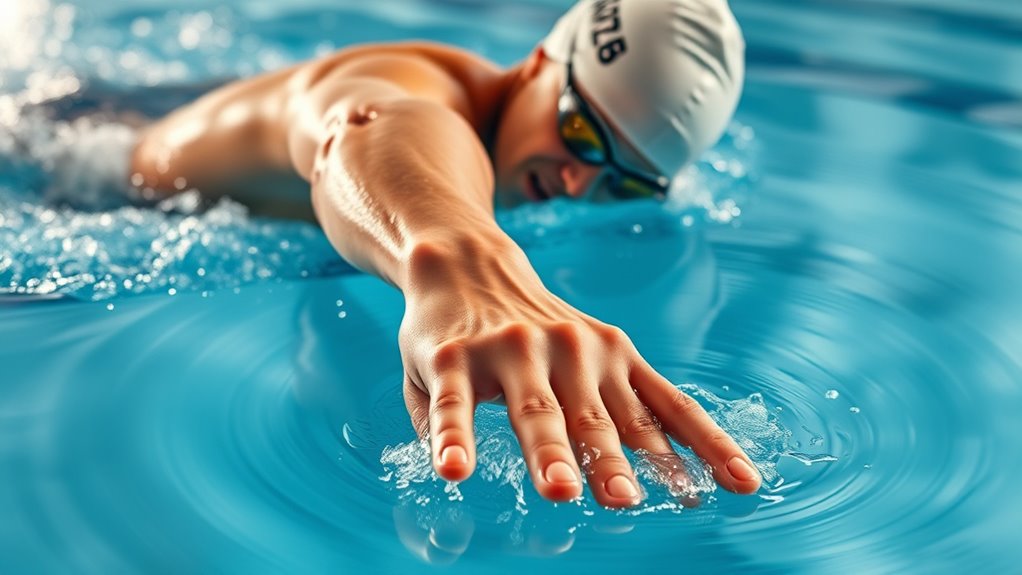
Building on your focus on arm timing from the Catch-Up Drill, the Fingertip Drag is a simple yet effective way to enhance your arm extension. As you swim, keep your fingertips lightly touching the water’s surface and drag them along during the recovery phase. This encourages a longer, more streamlined arm extension and promotes better body position. Focus on maintaining high elbows and slow, controlled movements to maximize benefits. Use this drill to develop a smooth, efficient arm reach without rushing. The table below summarizes key aspects:
| Focus Area | Technique Tip | Benefits |
|---|---|---|
| Arm extension | Drag fingertips, keep elbows high | Longer reach, better glide |
| Body position | Stay streamlined, avoid dropping hips | Reduce drag |
| Recovery phase | Move slowly, maintain control | Improve arm awareness |
| Breathing rhythm | Coordinate breath with arm movement | Consistent stroke flow |
Additionally, incorporating tuning principles from vehicle modifications can help you fine-tune your swimming mechanics for optimal performance.
Kickboard Kicks for Stronger Legs
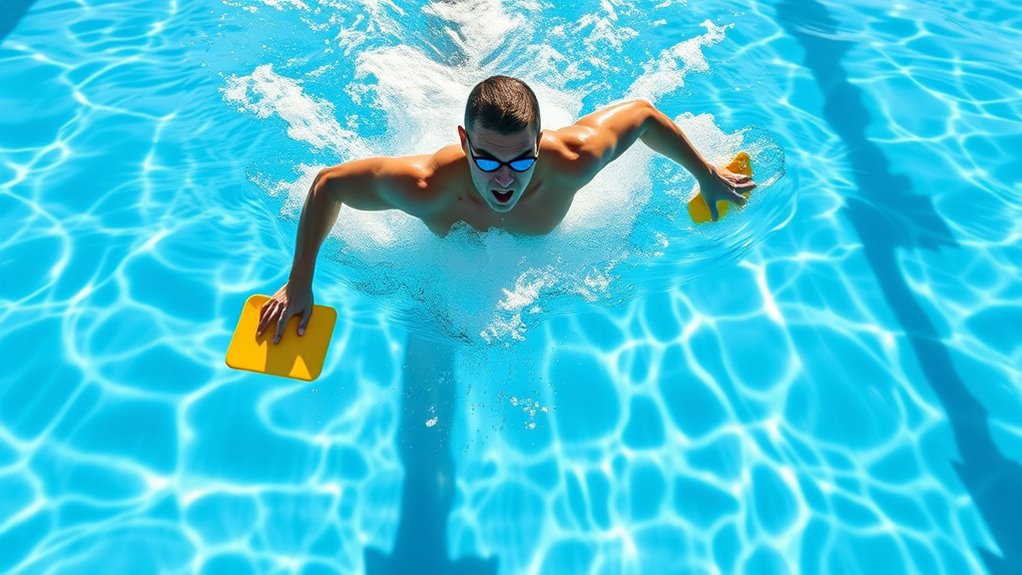
Using a kickboard during your swim workouts is an effective way to strengthen your legs and improve overall propulsion. By focusing on kick techniques, you build muscle endurance and enhance your kicking efficiency. Start by holding the kickboard firmly in front of you, keeping your arms extended and your body streamlined. Use your hips and legs to generate powerful, rhythmic kicks, maintaining a steady tempo. Avoid overkicking or excessive splashing; instead, aim for smooth, controlled movements. Incorporate different kick styles like flutter or dolphin kicks to target various muscle groups. Regularly practicing kickboard drills helps develop leg strength, which translates to better propulsion and speed in the water. Keep your core engaged to maintain proper body positioning and maximize the benefits of your workout. Understanding decoding slang can also make your training more enjoyable and engaging.
3-2-1 Drill to Enhance Breathing Rhythm
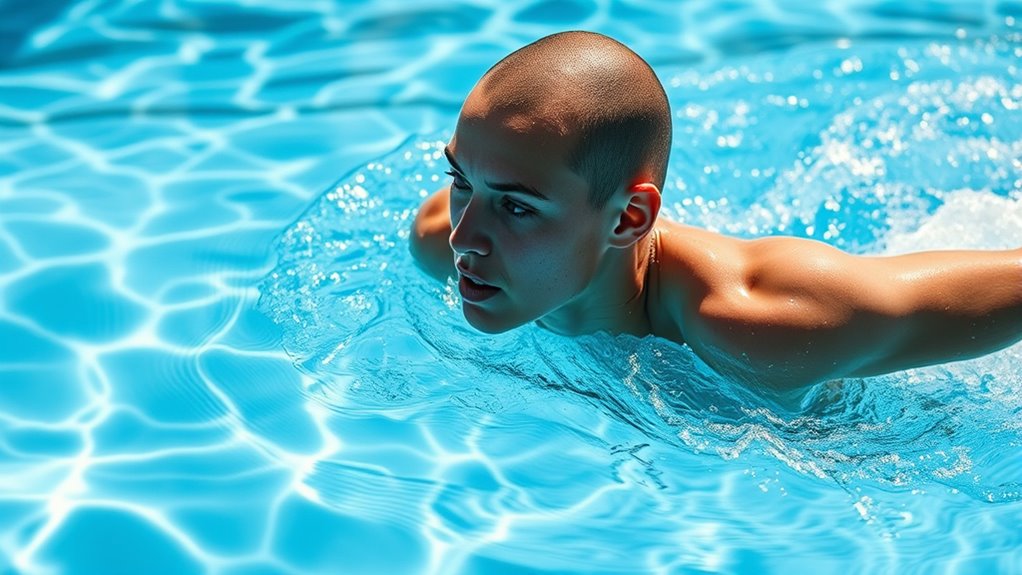
Focusing on your breathing rhythm can substantially improve your overall swimming efficiency. To develop better control, try this -1 drill. Begin by swimming freestyle, but with a specific focus on your breath. Follow these steps:
- Inhale deeply every third stroke, ensuring a smooth, steady breath.
- Exhale fully underwater during the two strokes between breaths.
- Maintain a relaxed head position to prevent unnecessary tension.
- Gradually extend your inhale to every fourth stroke as your rhythm improves.
- Remember to properly care for your synthetic wig to keep it looking its best during your Halloween festivities.
This drill helps you establish a consistent breathing pattern, reducing fatigue and increasing stamina. By consciously controlling your breath, you’ll find yourself swimming more smoothly and efficiently, making every lap count. Practice regularly to see noticeable gains in your breathing rhythm and overall speed.
Single Arm Swims for Focused Technique
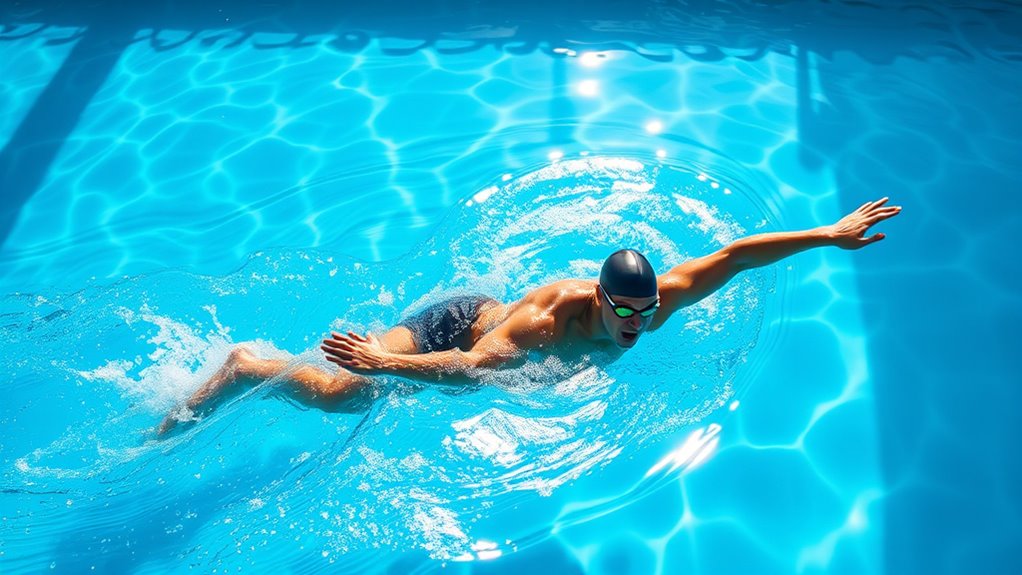
Single arm swims are an effective drill to improve your overall technique by isolating and strengthening your arm movement and body rotation. By focusing on one arm at a time, you can identify and correct weaknesses in your stroke, ensuring a more efficient pull. Keep your non-working arm extended or streamlined alongside your body to maintain balance and streamline your position. Concentrate on smooth, controlled movements and proper body rotation to maximize propulsion. This drill also helps you develop better coordination between your arm and core, leading to a more powerful and efficient stroke. Incorporating single arm swims into your training routine regularly can help you optimize your projector image quality and build confidence in your ability to maintain proper form throughout your swim.
Sculling for Better Feel of the Water

Building on your arm technique, practicing sculling helps you develop a better feel for the water and improves your control during each stroke. This drill enhances your sensitivity to water resistance and flow, making your movements more efficient. To get started:
Practicing sculling enhances water feel, control, and stroke efficiency for more powerful swimming.
- Keep your hands close together, with palms facing slightly outward.
- Move your hands in small figure-eight patterns, maintaining steady pressure.
- Focus on the water’s response to your movements, adjusting your grip as needed.
- Perform this drill at different speeds to refine your timing and feel.
- Regular practice of water filtration principles ensures you understand how water flows around your body, further improving your technique.
Consistent sculling sharpens your awareness of water dynamics, leading to smoother strokes and increased propulsion. It’s an essential drill that builds the foundation for more powerful, controlled swimming.
Pull Buoy Drills to Strengthen Pulling Power
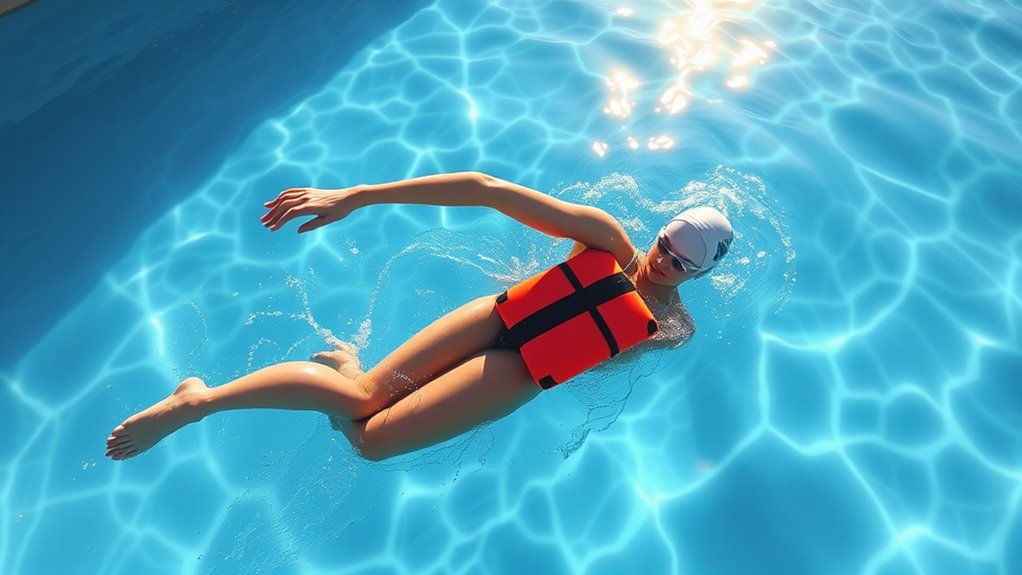
To enhance your pulling strength, incorporating pull buoy drills into your training routine is highly effective. Using a pull buoy isolates your upper body, allowing you to focus on arm and shoulder engagement without kicking. Start by positioning the buoy between your thighs, keeping your body horizontal and streamlined. As you swim, concentrate on long, powerful pulls, squeezing your lats and engaging your back muscles. Maintain a steady, controlled rhythm to build endurance and strength. Vary your drills by alternating between high elbow catches and full arm extension to improve pull efficiency. Consistent practice with a pull buoy helps develop the muscles needed for stronger pulls, ultimately increasing your swimming speed and reducing fatigue during races.
Vertical Body Position Drills

To improve your vertical body position, focus on keeping your body aligned and streamlined. Your head position is essential—keep it steady and look straight down to reduce drag. Verify your technique by analyzing your form regularly to ensure optimal efficiency and avoid developing bad habits. By maintaining these points, you’ll stay more buoyant and move efficiently through the water.
Maintain Streamlined Alignment
How can you guarantee your body stays in a straight, streamlined position during your swim? Focus on maintaining proper alignment with these key drills:
- Keep your hips high in the water, reducing drag and promoting a straight line.
- Engage your core muscles to support your spine and prevent sagging.
- Practice slow, controlled kicks to reinforce body position without losing alignment.
- Use fins or pull buoys to help feel the correct body posture and build muscle memory.
- Remember that fathers and daughters share a bond built on support and understanding, much like maintaining good body position requires consistent effort and awareness.
Focus on Head Position
Maintaining a proper head position is key to keeping your body aligned and reducing resistance in the water. When your head tilts too far forward or back, your hips and legs can sink, increasing drag and slowing you down. Focus on keeping your head in a neutral, streamlined position with your eyes looking straight down or slightly ahead. Practice vertical body position drills where you float upright with your head aligned over your shoulders. This helps you develop awareness of proper head placement and improves overall body balance. Use drills like single-arm swimming with head focus or vertical kickboard drills to reinforce this habit. Consistently maintaining a steady head position makes your stroke more efficient and helps you swim faster with less effort. Incorporating mindfulness and self-awareness techniques can further enhance your ability to maintain proper head alignment during each swim.
Speed Intervals With Focused Form

Speed intervals with focused form are one of the most effective ways to boost your swimming speed and efficiency. By alternating high-intensity efforts with rest, you train your muscles and improve endurance while maintaining proper technique. To get the most out of these intervals:
- Set clear targets: Focus on maintaining perfect form during each sprint.
- Use timers: Swim hard for 20-30 seconds, then rest for 30-60 seconds.
- Prioritize technique: Keep your head aligned, streamline your body, and control your breathing.
- Track progress: Record your times and refine your form with each session.
This approach ensures you’re not just swimming faster but doing so efficiently, reinforcing good habits that translate to all your races.
Flip Turn Practice for Seamless Transitions
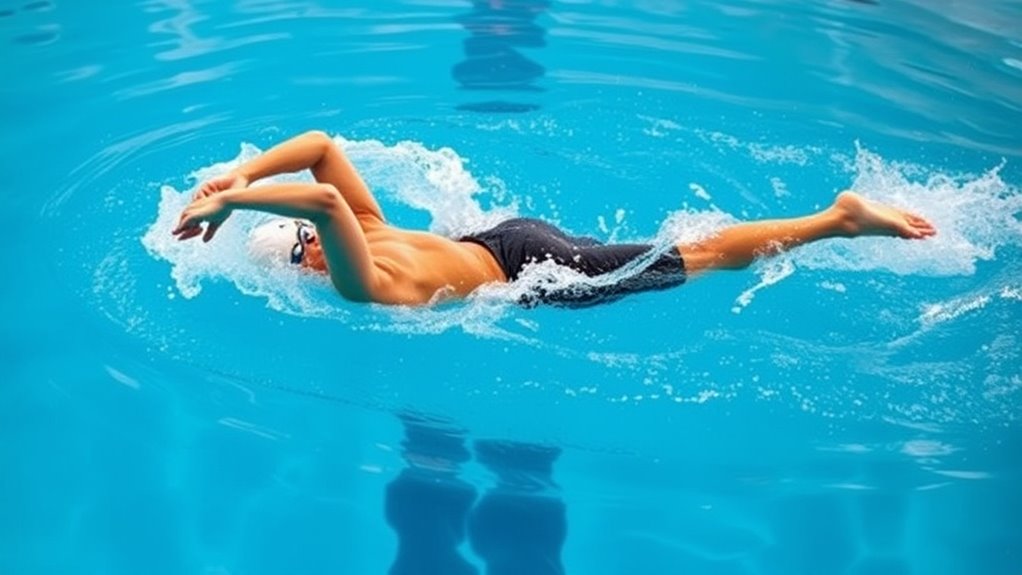
To master seamless flip turns, you need to focus on perfecting your push-off technique and streamlining your flip motion. Small adjustments in your push-off can substantially boost speed, while a smooth, tight flip reduces drag. Practice these key points consistently to make your transitions more efficient and effortless.
Perfecting Push-Off Technique
Mastering the push-off is essential for smooth flip turns, as it propels you into the next stroke with minimal drag. To perfect this, focus on these key steps:
- Position your body correctly against the wall, keeping your streamline shape.
- Push off powerfully with your legs, extending fully and engaging your core.
- Maintain tight streamlining as you leave the wall, arms extended and legs together.
- Practice controlled glide to maximize distance and minimize resistance before initiating your next stroke.
Streamlining Flip Motion
Achieving a seamless flip turn relies on perfecting your streamlining flip motion, which helps you shift smoothly from the wall into your next stroke. Focus on executing a tight, controlled rotation, keeping your body aligned and compact. As you approach the wall, tuck your chin to your chest and initiate the somersault with a quick, fluid motion. Extend your arms overhead and tighten your core as you flip, maintaining a tight tuck position to minimize drag. Once upside down, streamline your body by locking your hands above your head and squeezing your legs together. As you push off, keep your body straight, gliding effortlessly. Practicing this fluid, efficient flip turn guarantees smooth transitions, conserving momentum and allowing you to swim faster with less effort.
Breath Control and Rhythm Exercises
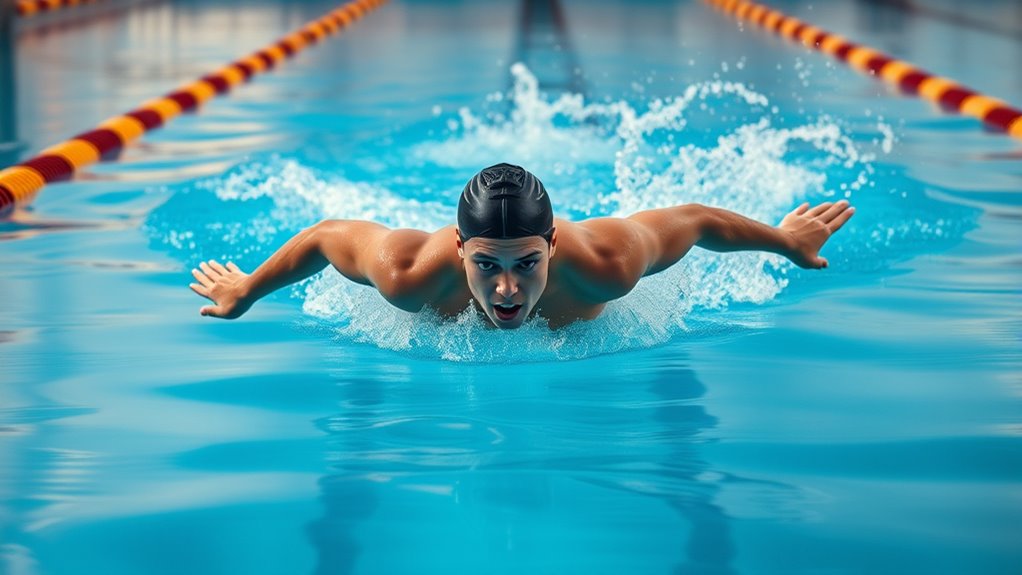
Breath control and rhythm exercises are essential for building efficiency and endurance in the water. They help you maintain a steady pace and conserve energy during longer swims. To improve, try these exercises:
- Bilateral breathing drills: Alternate breathing sides every three strokes to develop even lung capacity.
- Breath-hold practice: Swim a set while holding your breath for a specific number of strokes, then exhale slowly underwater.
- Rhythm counting: Count strokes per breath to establish a consistent breathing pattern and timing.
- Exhalation focus: Exhale fully underwater before inhaling to maximize oxygen intake and minimize surface time.
Incorporating these drills regularly helps you stay relaxed, control your breathing, and swim with greater rhythm and stamina.
Frequently Asked Questions
How Often Should I Incorporate These Drills Into My Swim Training?
You should incorporate these drills into your swim training about 2 to 3 times a week. This frequency allows you to focus on technique without overtraining, helping you improve steadily. Make sure to vary your workouts and include rest days to prevent fatigue. Consistency is key, so stick to this schedule, and you’ll notice better form and faster swimming over time.
Can These Drills Benefit Open Water Swimmers as Well?
Yes, these drills benefit open water swimmers too, even though they’re designed for controlled pool environments. While open water presents challenges like waves and currents, perfecting your technique in a steady setting builds a strong foundation. You’ll develop better body positioning, breathing, and stroke efficiency, which translate well to the unpredictability of open water. Incorporating these drills regularly helps you swim smarter and faster, regardless of where you’re training.
Are These Technique Drills Suitable for Beginner Swimmers?
Yes, these technique drills are suitable for beginner swimmers. You’ll find that they help you build a strong foundation in proper form and breathing, which are essential early on. By focusing on simple, controlled movements, you can improve efficiency and confidence in the water. Just make sure to start slowly, listen to your body, and gradually increase intensity as you become more comfortable with the drills.
What Equipment Is Essential Besides the Endless Pool?
Besides the endless pool, you’ll want a good pair of swim goggles to see clearly underwater and a swim cap to reduce drag. A kickboard helps focus on your leg technique, while a pull buoy assists with arm movement and body positioning. Consider fins for added propulsion and a stopwatch to track your progress. These essentials support your training, helping you swim faster and more efficiently.
How Do I Measure Progress With These Technique Drills?
You can measure progress with these technique drills by tracking your consistency and improvements over time. Use a waterproof stopwatch or app to time your swims and record each session. Pay attention to your form, stroke efficiency, and breathing. Notice if you’re reducing your lap times or feeling less fatigue. Regularly review your progress, set specific goals, and celebrate milestones to stay motivated and see how your technique enhances your speed.
Conclusion
By incorporating these drills into your routine, you’ll see your swim speed improve and your technique become more efficient. Sure, it might feel like a lot at first, but picture yourself gliding effortlessly through the water, turning seamlessly at each end. With consistent practice, those small improvements add up, making your swim feel easier and more confident. Stick with it—you’ll be amazed at how quickly your pace transforms and your passion for swimming grows.
